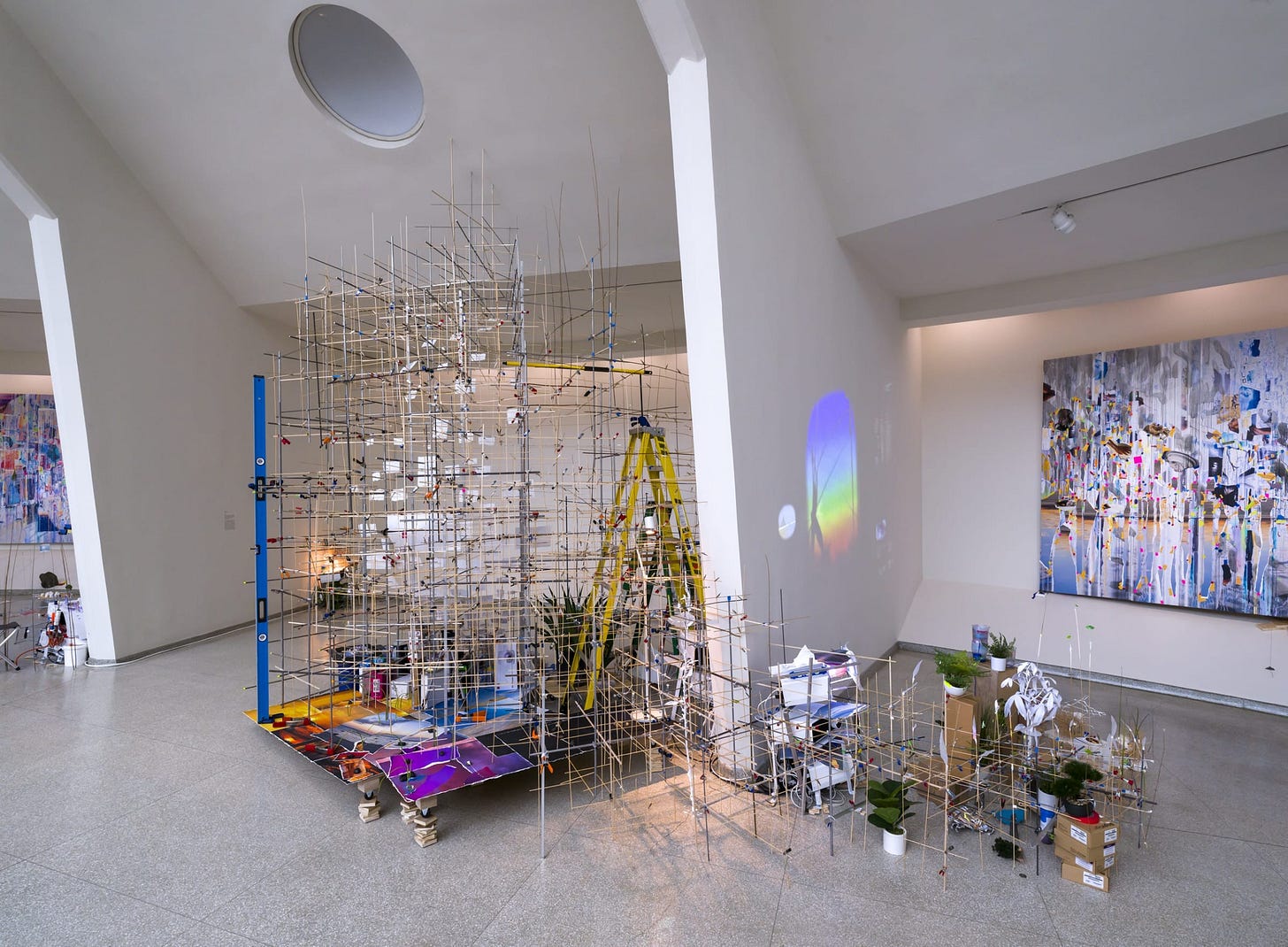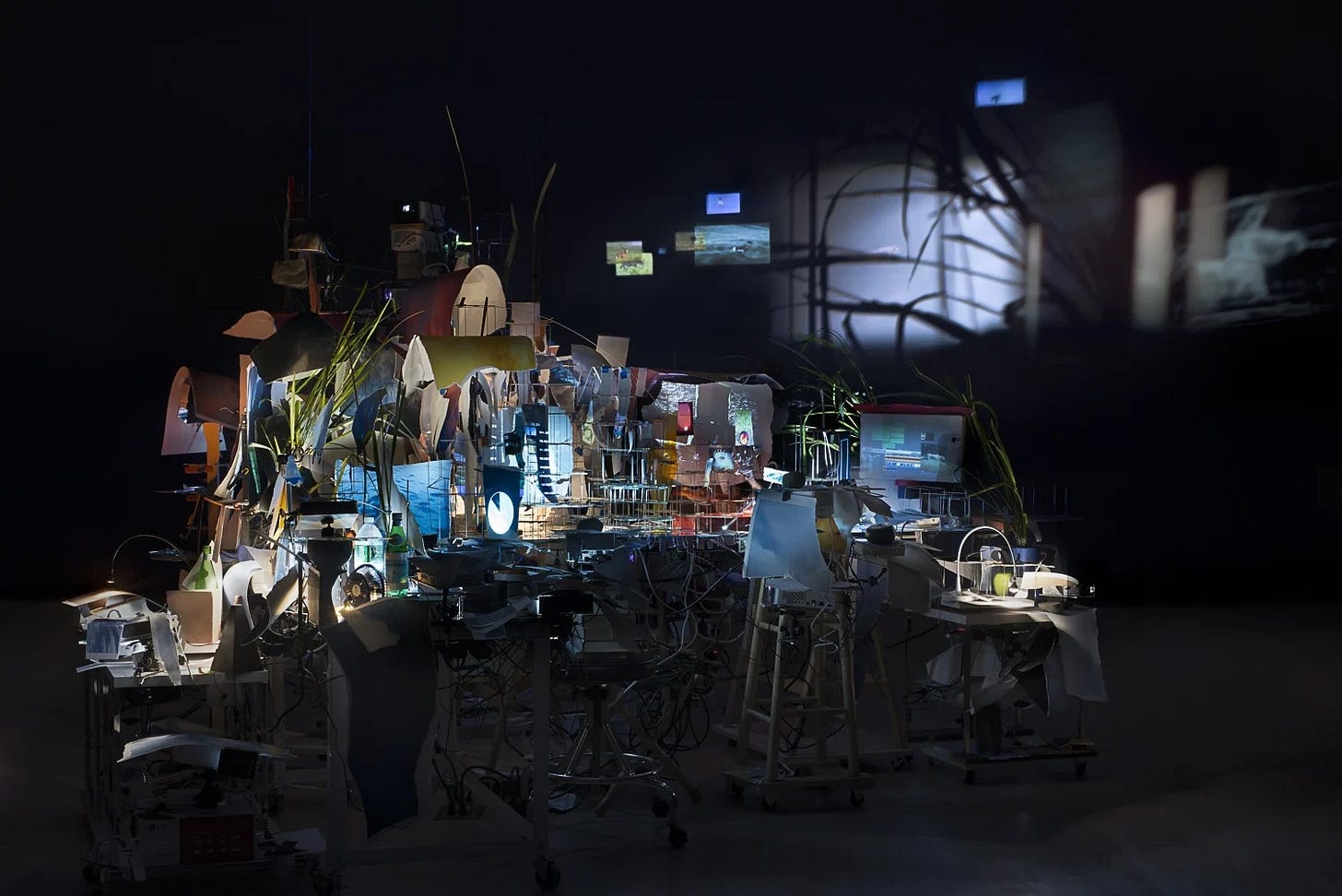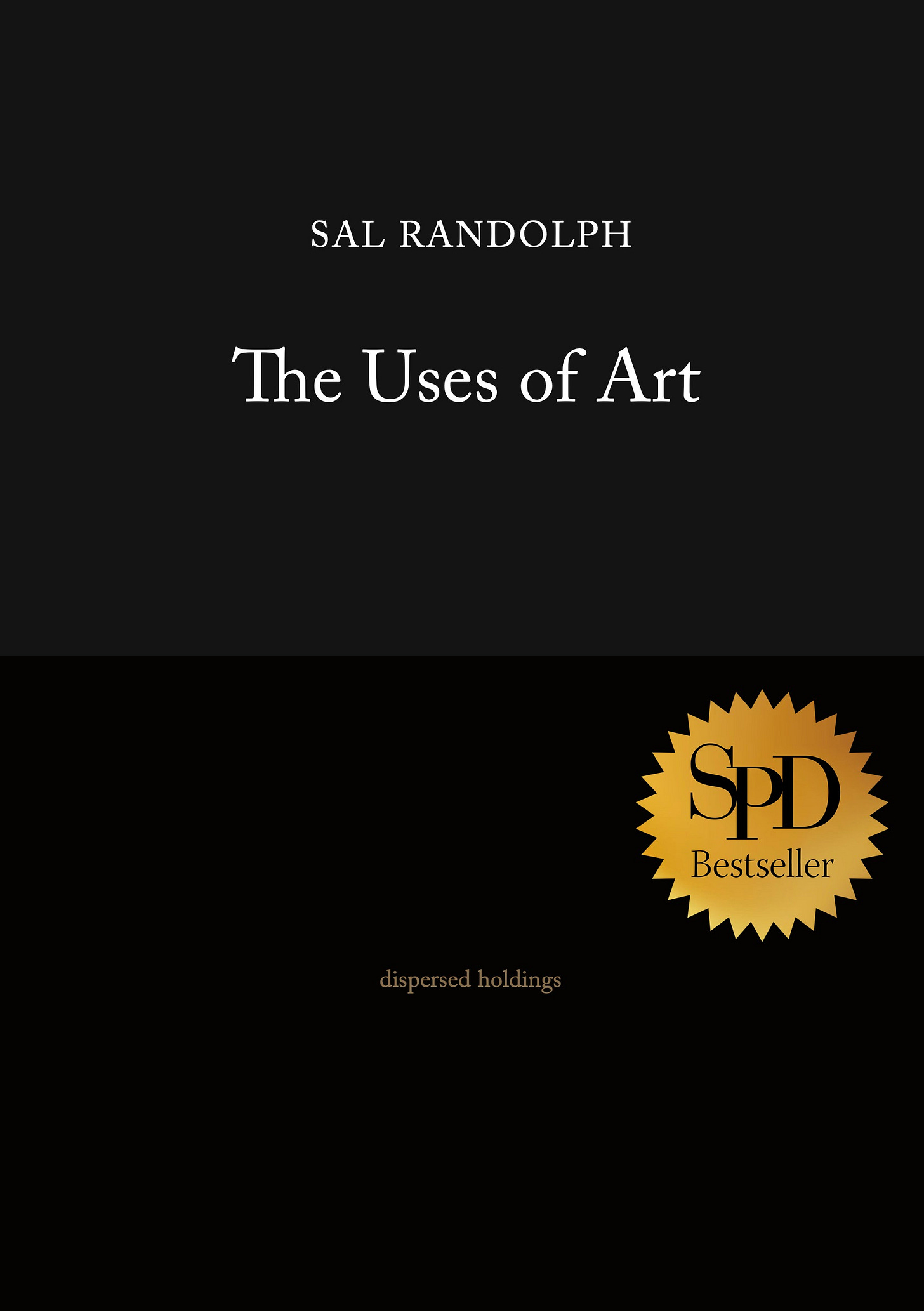Dear Friends,
For months I’ve been wrestling with Sarah Sze’s exhibition at the Guggenheim. Honestly, I still don’t quite know what happened to me.
With some artists it’s not one piece or one show but the accumulation of experiences over years. For me, Sarah Sze is like this. I’m not at any kind of end point, so you see me here in the mist of a journey. At times it almost seemed like the classic heroine’s journey described by Joseph Campbell. I set out on the journey, but did I make it back home?
To experience art, to write about the experience of art, is to risk defeat. Here’s what’s consoling (as an artist) and inspiring (as an experiencer of art): whatever the experience of one visitor, on one occasion, the work is always much larger. Paintings, sculptures, installations all persist past any single moment. Performances are refracted across multiple audiences. Every work of art is inexhaustible, available to infinite interpretations and uses.
— Sal
Swoon
A kind in glass and a cousin, a spectacle and nothing strange a single hurt color and an arrangement in a system to pointing. All this and not ordinary, not unordered in not resembling. The difference is spreading.
— Gertrude Stein, Tender Buttons
Sometimes Sarah Sze kills me, and sometimes she brings me back to life. One could say this is the sign of a teacher. During the five months that Sarah Sze’s show Timelapse was up at the Guggenheim I went and went—I’ve been trying to write about it for all that time. Something about the show tangled me up or unmade me.
If you’re not familiar with her work, Sarah Sze is known for her complex installations where hundreds of objects are arranged in formations that suggest observatories, laboratories, work desks, or studios. There is a strong sense of a mind thinking, puzzling, working something out. Her pieces typically contain objects you might find in such a space: empty boxes, jars of paint, ladders, levels, clamps, projectors, tape, string, models and bits of work in progress. You will also see a multitude of images in the form of photographs and projections. The assemblages are typically animated by motion: a fan that makes something flutter, a pendulum swinging, a projector that rotates, water that ripples.
At the Guggenheim, Sze’s project begins with a hammock of strings hovering over the rotunda’s eye-shaped pool. It continues on the upper ramps with a mix of new and old work, installation and painting, until you come to the centerpiece, a darkened room containing Timekeeper from 2016, now in the collection of the museum.
Each time I climbed the ramp and entered that dark rooom, I suffered from something like Stendhal syndrome, the semi-mythical disorder, the swooning dizziness or collapse that comes from seeing too much art. I’ve known her work for years, and seen many of her shows, why was it having this effect on me?
Journey
On one trip, I thought to myself, what if this were a story? Maybe something like the archetypal heroine’s journey. Why, after all, did art writing so rarely take the form of fiction?
I began by making a list of the characters in the tale. Fans, studio lights, stepladders, tripods, extension cords, clamps, kleenex, projectors, post-its, studio tape (orange, chartreuse, blue), clocks, slides and photographs, mirrors and shiny surfaces, foil, tools, paint, string, stalks, rocks, potted plants, wood strips, spools of wire and string, glue, bubble wrap, paint containers, models and studies, spheres and part-spheres, books, stools, thread, toothpicks, water, clothing, salt, plumb-bobs.
There were also characters that appeared repeatedly in Sze’s in torn photos and projected videos: fire, lava, hands, water, whirlpool, static or snow, iceberg, splash, wave, sand, geyser, cheetah, flame, wave, face, sleep, cloud, light, moon, sky, ocean, bird, the sun, sunset, midday.
I’ll admit these characters didn’t make a story easy. They were more like multitudes or atmospheres than individuals. The night sky with its panoply of stars. A forest with its millions of leaves. A cityscape. The vast image banks of the internet.
Inventory
Reading interviews with Sarah Sze, I came across this remark. Art critic Erika Balsom asks Sze about all of the mass-produced objects in her work, and Sze replies:
We verbally name the things we can see and we make an inventory of them. This is how we’re trained to re-establish our sense of location. When you take an object out of its context, it loses its meaning and becomes only a list of materials. It’s like looking at a sculpture by Eva Hesse and saying: ‘It’s three gallons of latex, three strings’ and so on, when the whole point is that these materials have been transformed by both their treatment and their location. Or, it’s like taking an Emily Dickinson poem and putting the words in listed categories – verb, adjective, noun – and then saying: ‘Isn’t this interesting?’ It’s not. People have a desire to dissect the work and take back control over the objects by turning them into words that can be understood.
Frankly, this stung a bit.
For me, cataloging and listing are fundamental to really seeing—inventorying is a practice I do with all kinds of art. What are the shapes, what are the colors, where is the dark and where is the light? What are the images or the repeating elements? A task like listing or collecting gives your mind a kind of itinerary, and attention wakes up when you have a task.
Further, I’m going to differ with Sze on Hesse and Dickinson.
Out of sheer contrariness, I tried Sze’s experiment with a poem of Emily Dickinson’s, Banish Air from Air - (963).
Banish Air from Air -
Divide Light if you dare -
They'll meet
While Cubes in a Drop
Or Pellets of Shape
Fit -
Films cannot annul
Odors return whole
Force Flame
And with a Blonde push
Over your impotence
Flits Steam.
Sorted by it’s parts, this poem becomes:
Banish, divide, dare, meet, fit, annul, return, force push, flits
Air, light, cubes, drop, pellets, shape, films, odors, flame, blonde, impotence, steam
From, if, you, they’ll, or, of, cannot, and, with, a, over.
While these lists of words are not the poems, they do illuminate something about the poems, at least for me. Admittedly, “Banish Air from Air” is one of Dickinson’s most enigmatic poems. I tried it again with other poems of hers, and the results felt similar. The inventories have their own moods and invocations. Maybe they are a little like spells.
As for Eva Hesse, I do think that a list of Hesse’s materials is meaningful. What I see in Hesse’s sculpture is a mind and body at play with exactly this material world. Materials are not just minions in her arrangements. Latex is not bent to Hesse’s will, but neither does it lie still and limply liquid in its bucket. Hesse’s strings and ropes do not remain in their coils, hanks, and balls, but get loose and insist on their stringiness and ropiness. Latex and rope and Hesse become something together, in the act of experiment and play. Her work emerges out of this interaction of self and world.
There’s a way in which Sarah Sze’s work does the same, but Sze’s objects are not so much transformed by their encounter with each other as organized by their placement and juxtaposition.
Arrangement
There is a strangely compelling satisfaction, almost like a form of ASMR, to seeing things arranged, organized, arrayed. There is the pleasure of seeing like objects in simple patterns, but the more the objects themselves invite disorder—through irregularity, through variousness, through uncategorizability—the more deeply satisfying the impositions of arrangement feel.
Among Sze’s favorite rhetorics of arrangement are the radial—the circle, the sphere, the whorl (as in fingerprints). She loves the expanding, and the angular—the converging/exploding of perspective. She also loves the array, the line, the scatter, the plain mess. She uses the grid—in two dimensions and three—as order, as structure, as scaffolding.
In Dickinson’s poems, the difference between the inventory of words and the poems themselves is inherent in the way words and syntax make meaning. Dickinson’s words, made into lists, never feel messy. The order of her mind and of her poem permeates the vocabulary she deploys.
Sze’s mind is wilder and contains a superabundance of objects and images. Without arrangement, Sze’s work would be the mess, or jumble, that it courts. Everything teeters between the poles of order and chaos. In this way, it naturally echoes the productive mess of the studio. Art studios, too, operate between these poles. Order makes it possible to see what you are doing, what you have made, what you might make. Disorder allows for the making itself to emerge. Between order and disorder is play.
Fiction
If Sarah Sze were a fictional world, what kind of world would she be? If Timelapse were a novel? It would be a novella of fragments and shards, of repetitions and juxtapositions. It would be simultaneously futuristic, of the present, and nostalgic. It would hide a romance on its sleeve. It would confound by its variousness.
In a talk, Sarah Sze said that she saw her work as occupying rooms and walls, but most of all she wanted it to occupy memory. Taking this one step further, it seems to me that Sze wishes to occupy the parts of the mind that operate below the threshold of consciousness. In the deep self memory and imagination merge, perception mingles with dreams. It is perhaps here where our experience of being-in-the world is forged.
Dream
I dream I am in a forest that is also somehow a city. The forest-city is also an observatory, a movie theater, and a clock. I have a task. I need to find a guide. I was told to follow a string, but strings are everywhere. Sometimes, in this dream, I am tiny. I am the size of a Q-tip. No, once I was a Q-tip, but that was somewhere else. I am the size of a pill, of an aspirin, a small white disk among other small white disks, a row of us. No, that is also a memory. Sometimes I am the size of a jar of paint, or a bucket. Sometimes I am the size of a stepladder. Sometimes I am a building, or a mountain. This is not a dream, it’s a fairy tale. I have been sent into the forest, but I am only a child. I have an impossible task: to find the control room, the center, the heart of the forest. To find the red thread that will lead me back out. Ariadne’s thread in the labyrinth.
I climb the slope, moving slowly. My eyes dart. It is as if there was an explosion, or the explosion is happening right now in slow motion, or there are models of the explosion all over. Now I am tiny not in space but in time. I am just a now, flashing and flashing. All around me time repeats in cycles I can’t quite understand. The sun is everywhere, setting and rising and concentrating the blue of the sky. The sun is a burning pot of fire. There are white clouds. There is the sensation of rainbows. Sometimes the transmission is just static. I see birds everywhere and I want to follow them. Divination by the flight of birds: ornithomancy. Oracles, arrows, pointers. I climb onward until it is dark, until I enter a murmuring cave. The moon flashes by, circling and circling. Metronomes, fans, digital clocks. Milk splashes into milk. Is this ecstasy or is this a monster? I grow faint. I have forgotten everything and remembered everything. Where is my guide? I lie back in the swirling and pulsing.
It is a cave of never-ending darkness, never-ending light and perpetual motion. Here is the death and life, the danger and perishing, the machinic life, the life of images. Visitors circle and dance, wielding their phones, speaking the image-language of the work back to the work. “Look at the moon!” “It’s pixellated!” Two young women sing into their phones. It’s like the last boss in a video game, it’s like the heroine’s abyss. Three times dizzied and defeated I lie back on the large square bench, repenting of my own timidity. I don’t know yet if I have emerged.
Sarah Sze
Sarah Sze: Timelapse was on view at the Guggenheim Museum March 31 through September 10, 2023.
Sarah Sze at Tanya Bonakdar Gallery.
More Sarah Sze on The Uses of Art:
Double Take
Dear Friends, I’ve followed Sarah Sze since I came across an early catalog of her work almost 20 years ago. Right now there is a generous selection of her installations and paintings on view in the upper reaches of the Guggenheim’s spiral (along with an amazing show by the late Venezuelan artist, Geg…
Further adventures and new ways of seeing can be found in my book, The Uses of Art.
Artist Sal Randolph’s THE USES OF ART is a memoir of transformative encounters with works of art, inviting readers into new methods of looking that are both liberating and emboldening.
Dazzlingly original, ferociously intelligent.
— Michael Cunningham
A joyful, dazzling treasure-box of a book.
— Bonnie Friedman
Here’s a guide, to waking up, over and over again.
— Roshi Pat Enkyo O’Hara










Wow, that installation sounds so interesting. I had an experience recently at Tate Modern, seeing the work of Hilma of Klint and seeing and feeling the beautiful commonalities and themes of existence. It's hard for to put to words really - apart from its the only art exhibition I've ever bought the big expensive book for. And that dream part at the end of this post - magnificent. I will remember it when I write a sort of dreamy pastiche short story I have in the works.
It was up for five months! I managed to procrastinate for five months and miss this show! Damn!